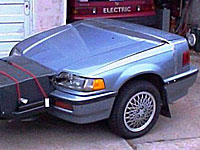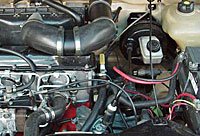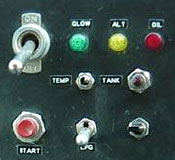EV Pusher · 12 May 06

Psst…
Hey…
Hey, buddy!
Hey, yeah, you! You wanna buy an EV? Check out my suitcase here, I got all of the popular ones. Blue, red, black, white, and even some of them, whatcha call “off colors”.
And for you? Well, beings that I like ya I’ll let her go real cheap!
And then there’s the other kind of EV Pusher…

This is an electric car “pusher” from Mr. Sharkey . EV Pushers are typcially a fuel powered (gas, diesel, etc..) vehicle re-purposed as an EV add-on. Most of the time it’s sitting in the garage at home, but when you want to go on a longer trip you hook it up to the EV and away you go.
Let’s talk about the relative merits of this approach.
Essentially what you have here is a hybrid car taken to a more logical configuration. Hybrids are all the rage right now but, for most folks, even a hybrid is overkill. They commute ten to twenty miles a day, five days a week, a perfect setup for driving an EV. They get a hybrid because: A) nobody sells EVs, and B) what if they need to drive further? (horrors!)

So they buy a hybrid and that’s pretty cool, mpg is a little better and emissions are lower. Then they start to hear about plug-in hybrids: extra batteries are added, you plug it in at night, and most of the time the gas engine NEVER turns on. You might drive for weeks or months without using any gas!
Cool!
Except the plug-in hybrid isn’t as efficient as a regular electric vehicle. What’s up with that? Well, for one, the poor plug-in hybrid is essentially hauling around two complete drive systems but mostly using one or the other. When driving around pure electric there’s all of this fuel, gas engine, and related gear being dragged around like an anchor tossed out the back.
A plug-in hybrid is what they call a gateway drug. It’s a clever ploy by the EV folks to convince people that what they really want to drive is an electric car.
“Yeah, but, what if I want to go on a long trip a couple times a year or even once a month?”
Well, you could rent a car: much cheaper than monthly car and insurance payments, inspections, and upkeep. You could even splurge and get one with big cup holders.
Or you get an EV pusher, like Mike Chancey’s…

There’s probably dozens of ways to add a combustion engine to an EV and a hybrid simply puts it under the hood in such a fashion that it can’t be removed when you don’t need it.
Sharkey, Mike, and others have created a separate module. And instead of re-inventing the wheel they simply used an existing car.

Mike used a 1988 Honda Civic. What used to be a 2,300lb car is now an 800lb pusher.
The photo shows the back end being sliced off, which Mike says only took about fifteen minutes. Probably the harder part of the project is enclosing the “back end” and running the control electronics to the EV.
To enclose the back Mike sectioned the rear sheet metal over the back of the front sheet metal and secured it with screws, then added angle braces between the floor and the inside of the back wall, which gets welded and refinished. The trunk lid has been cut back and hinged on a piano hinge.

The gas tank lives on top of the tongue under the black plastic cover. There are three trailer wiring connectors from the trailer to the car. One for the lights, one for the engine, and one for the cruise control. Disconnecting any one shuts the trailer down. The trailer control switch in the car shuts it down from the dash and shutting off the car shuts down the trailer as well. Stepping on the brake drops the cruise back to idle.
And how do you inspect it?
Just another home built trailer. I told the mechanic at the inspection “Don’t ask too many questions and we both will be happier”. While he was filling out the paperwork one of his coworkers walked up and asked, “Is that a pusher?”
Since the pusher has an automatic transmission and the motor has cruise control he doesn’t really need to control the accelerator. As soon as it gets above 25mph, using the electric motor, he can engage the cruise control and the gas engine takes over.
A little more info from Mike:
The transmission is left in drive and the neutral safety switch has been bypassed to allow it to start in drive. I usually start it while stopped but I have started it while moving. Above about 25 MPH you have trouble hearing the trailer, but the engine oil warning light going out makes a good indicator that the engine has started.
I am working on a direct throttle solution to allow the pusher to handle pushing the EV off from a stop. After trying a vacuum servo from another cruise control I ended up with a motorcycle twist grip mounted on the parking brake lever. I am still working out the cable connection, but this looks like a functional solution.
Also, I am adding a circuit to allow the 12 Volt loads on the EV to be handled by the pusher and am adding a 600 watt inverter to power the 120 VAC charger on the EV to trickle charge the EV’s batteries. I have a 3000 watt belt driven generator to mount on the pusher engine, but so far exactly how has eluded me. The engine compartment is pretty tight.
One of the advantages of using an existing car engine is that all of the emissions control and fuel efficiency computers are already included. None of this bolting an inefficient, stinky old backup generator onto your EV and hoping it holds up.

Mr. Sharkey’s EV pusher has been around longer. Originally started back in 2000 it has gone through a few enhancements over the years.
The current model sports a Volkswagen 1.6 liter, four cylinder diesel fueled by biodiesel. The motor gets around 48mpg, but once in place and pushing itself and the EV around the overall mileage is closer to the 25-30mpg range. He also has some LPG fumigation tricks up his sleeve.
Here’s the remote engine control for his EV pusher. A couple status lights and a few switches. He sent an email to explain the functions:

- upper left, ignition on/off
- big red button, starts engine
- temp/tank, switches EV fuel gauge between the pusher engine’s temp and fuel sensors
- little red push button: squirts water! Not at other cars but across the radiator to augment cooling on long, tough hill climbs in the summer
- the LPG switch arms the fumigator (surely there’s a movie plot in that line alone…)
- bottom right unlabeled switch, momentary accelerate/decelerate for tweaking speed without resetting cruise control
While you are over at his site be sure to check out his adventures with the ecotrekker (a TV show which ended up being called Cool Fuels Roadtrip).
Of course he has also documented his electric car conversion and his electric lawn tractor.
One of the things that has always intrigued me about an EV pusher is that it’s the kind of thing that would be perfect to share with others. Either in a co-operative setup or as something you could rent for a weekend. The controls don’t need to be very complicated and by its very nature there’s really not much interaction between the gas motor and the on-board electric.
Sharkey points out that the pusher approach is non-vehicle specific, it could even push another gas vehicle for that matter. I think it was Darin who put forth the idea that you could instead make a Pusher EV: an outboard electric car that pushed a gas car.
These EV pushers, just like our homemade EVs, are making the best of existing technologies and, in a sense, recycling old/worn out vehicles. There’s nothing overly complicated about the design and it’s something that could easily be commercialized. A manufacturer (even an auto maker if they were so bold) with the aid of modern design tools and components, onboard computers, common parts, and the benefits of bulk manufacturing could crank these out relatively cheap.
A pusher doesn’t need a front bumper, crumple zones, or even much in the way of shocks or brakes. As a bit of a thought exercise I have been trying to imagine what it would take to use the back half of motorcycle as a pusher.
I should mention that I don’t think an EV Pusher (or even an EV) is going to fit everyone’s needs. If you have a long commute (some folks say they commute over a hundred miles a day) then a pusher is probably the wrong approach, a hybrid would be a much better fit (or moving). Just as it makes no sense to haul around a gas engine when the majority of your driving is short range, there’s also no reason to haul around lots of batteries when the majority of your driving requires the combustion engine.

